| کد مقاله | کد نشریه | سال انتشار | مقاله انگلیسی | نسخه تمام متن |
|---|---|---|---|---|
| 4732909 | 1640487 | 2016 | 24 صفحه PDF | دانلود رایگان |

• Fault intersection patterns in the Lufeng Sag in northern part of South China Sea.
• Analogue models are used to simulate the evolution of intersecting fault systems.
• Non-parallel conjugate basement faults form horst-graben pair in cover units both in profile and map view.
• Seismic data from Lufeng Sag verify the predicted intersection geometries from the models.
• Results are applicable to other areas where non-parallel conjugate basement faults propagate into cover units.
Interpretation of seismic data from the Lufeng Sag of the Pearl River Mouth Basin (PRMB) in the northern part of South China Sea shows that different intersection patterns developed in the cover units above basement normal faults. A series of analogue models are used to investigate the intersection patterns and deformation in the sedimentary cover sequences above a basement horst bounded by two non-parallel faults. Modelling results show that during their upward propagation, the basement faults may intersect within the cover sequences and form a graben above the basement horst. Length and width of the graben increase with cover thickness. The strike and dip intersection points are controlled directly by the thickness of the cover sequences, dip and strike of the basement faults, and width of the basement horst. The intersection point migrates along the axis of the graben toward the wide end of the basement horst, when the cover sequence thickens. In contrast, it migrates toward the narrow end of the basement horst, where both fault dip and angle of strike difference increase. The intersection point moves upward with increasing width of the basement horst crest. Model profiles also indicate that in the presence of a ductile layer between the cover and basement such intersection patterns do not form. Interpretation of seismic data and model results show that the intersection pattern developed in the Lufeng Sag is a result of propagation of basement faults into cover units during different extension stages of the basin. Results of this study can be applied to many other sedimentary basins where such fault intersection patterns are likely to form when non-parallel conjugate basement faults are active during sedimentation.
Journal: Journal of Structural Geology - Volume 93, December 2016, Pages 67–90